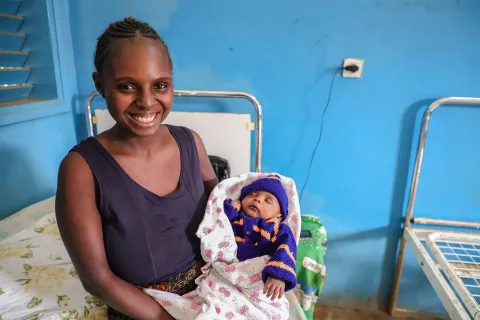Innovation at the heart of humanitarian response
UNICEF embarked on a co-creation process to develop new tents, bringing manufacturers to the field and enabling the creation of a fit-for-purpose, multi-functional product for programme implementation.

Tents have served UNICEF well for many years. The changing nature of humanitarian crises – including climate change and protracted emergencies – has posed new challenges to ensuring these spaces remain safe and secure. Extreme weather exposes tents to increasing risks of collapse and larger temperature variances, making it too hot or cold inside them. These environments can negatively affect a child’s ability to fully benefit from the services being provided.
Co-creation with the private sector
UNICEF explained its needs for a new type of tent to industry partners and identified more than 1,000 requirements, including resistance to extreme weather, improved indoor temperature, increased internal space and ease of transport and set up.
The co-creation approach involved UNICEF and different manufacturers collaborating through a trial-and-error process, where prototypes were developed and tested in labs.
This included a climatic wind tunnel where hurricane-strength winds and below-freezing temperatures were simulated to test durability, thermal performance and ventilation rates.
UNICEF took the prototypes and manufacturers to three field locations to understand how climate impacts different emergency contexts: Uganda was selected to represent hot and dry conditions, the Philippines for wet and humid conditions and Afghanistan for bitterly cold temperatures.

The final product
The UNICEF High Performance Tents include a number of enhancements to improve efficiency and make life more comfortable for children in emergencies.
The innovations include:
- A new anchoring system to keep the tent properly secured and improve durability to withstand extreme weather.
- A straight wall design to provide 20 per cent more usable floor space while keeping the same footprint as the existing tents.
- A three-layered window system made from a mosquito net, transparent sheet and full cover to improve lighting and ventilation, with an additional built-in shade net to help control the temperature inside the tent.
The High Performance Tents will have a significant impact on UNICEF work in humanitarian emergencies worldwide. In 2020, UNICEF will scale their distribution, whilst phasing out old tents.
With an average procurement of 4,650 multipurpose tents per year, the new tents will provide improved services to millions of emergency-affected children.
The High Performance Tents can also be tailored and equipped with add-ons including
- Solar and electrical kits to provide illumination and improve safety at night
- Hard flooring to provide safer, cleaner environments in muddy conditions
- A winter liner for cold climates
- An inner liner to create a more intimate feel for child friendly spaces




